Filling the Gaps
adding details when recipes are a bit succinct, plus January classes and recipe boxes at Hot Stove Society
There is so much to be said about so many facets to preserving beloved recipes—from the personal connections they represent to the various forms collections can take to the nuts and bolts of the recipe content—every topic can spark lots of discussion. So I’ll be looping back to revisit some standard themes as part of the conversation here. At least I feel pretty confident I won’t be running out of things to write about any time soon.
One such theme that I’ll touch on now and then is what I’ve come to refer to as “filling the gaps”—what to do with recipes that lack detail we really need to cook them ourselves, or to share with others who aren’t already familiar with the recipe (and need even more direction, often).
These gaps can be a particular issue on recipe cards, for a couple of reasons. One is the simple reality of space constraint: there’s only so much room on those cards, only so much detail can be shared. That might explain why so many of them—my mom’s included—contain shorthand, such as the “H2O” she often wrote in place of “water” or that symbol for “with” (a ‘c’ with a line over it, I recall). I’m not sure how much space those saved, but she and many others years back peppered recipes with these and other bits of shorthand. Sometimes perplexing to those reading them.
And so often, these recipes cards served as a memory-jog, the cook quite familiar with the general process and not needing every detail to be spelled out for their own use. The trick comes when that card gets passed along to others—the detail gaps can prove frustrating, or at least make clear where some updates would be beneficial for others who might cook from it.
One example comes from a friend who became the keeper of her family’s kringle recipe, the one who makes it every holiday season. She was fine with the long-time family recipe saying simply “make a glaze” but realized that before sharing the recipe with her kids she should jot down how she makes the glaze and add it to the recipe. Another friend told me about recipes of her grandmother’s, who was an excellent baker, that might lack even quantities for ingredients: when she wrote “add the raisins” she knew how much she needed.
From my family’s files, I have the toffee cookies to turn to as an example. It’s not lacking in detail to the degree that others might, but it exemplifies a few things to keep in mind when reviewing recipes in your collection that might benefit from a bit of additional information.
Above is the version from my mom’s recipe folder and below the one I recreated in a grade-school project for Mother’s Day gifts. My first cookbook collaboration! You’ll see how I tried to replicate my mom’s version as closely as I could. Though I did change the name from cookies to bars, and spelled out “squares” instead of just drawing a picture. Already an editor.
Some gaps that could use filling:
· a couple extra ingredients (egg white and nuts) sneak up in the midst of the method text, helpful to have all ingredients together at the top; also it would be good to mention that the butter should be at room temperature before blending
· maybe this would work if you literally just threw the dough ingredients in a bowl and “beat all together” as stated; unsaid is the detail of first creaming together the butter and sugar, adding the egg yolk, then working in the flour, which is surely what my mom (and Trudy before her) did
· at least it’s got a time listed for baking, where some recipes might not, but it’s always good to offer a sensory clue as well (color, texture, the toothpick test for a cake, etc.)
· no yield is provided, which is one of the most common gaps I see—maybe not as critical as ingredient and method details, but super helpful to those not familiar with the dish or not so practiced in the kitchen that they can guess from reading it
So, back to that reality of the limited space on recipe cards. I don’t know how many you are writing out recipes on recipe cards these days—I know I hadn’t done so for quite some time. But I found some blank ones in the recipe folder I started as a kid and tested myself with this recipe update.
I quickly realized that as someone who’s been writing recipes professionally for many years, shifting gears to recipe card format and dispensing with traditional recipe style I’ve used for so long is going to be interesting. Such as breaking the habit of describing how you cream the butter and sugar (“in the bowl of a mixer fitted with the paddle attachment or with electric beaters” as I usually might), just trusting that “cream the butter and sugar” will suffice. This adventure of celebrating the recipe box will include celebrating, and adapting my recipe-writing approach to, recipe cards as well. I’m ready for it.
Here’s how that went:
I’ll be actively working to get back in the recipe card groove—writing new ones, not just delighting in those from years gone by as I’ve done for so long.
January Workshops
I’m happy to be starting the new year with a couple of recipe workshops on the schedule.
I’m leading a workshop at The Community Library in Ketchum, Idaho, the afternoon of Wednesday, January 15. I am so very grateful to them for having hosted my first workshop a couple of years ago—when I wasn’t quite sure where all this would lead. Thrilled to be returning now for my third time. More details and registration available here. I’m also teaching a couple of cooking classes at Sun Valley Culinary Institute while there, in case they’re of interest too.
You’ll see a bit more about Hot Stove Society below, I’ll be leading a workshop at this downtown Seattle cooking school on the evening of Monday, January 27. They are adding some food to the mix here, making a few items from my mom’s collection that I’ll share some stories about during the workshop as well. Information and registration available here.
Recipe Boxes on Hot Stove Radio
I’ve known celebrated Seattle chef Tom Douglas for many years, both as a journalist writing about Seattle’s food scene, and as a fan of his restaurants. But it wasn’t until recently that I learned how much importance he places on the recipe box, how kindred a spirit he is in this mission I’m now on. When I dropped an email to the producer of the radio show he hosts, the Hot Stove Society Radio Show (produced in the cooking school space), about maybe coming on to chat about cherished family recipes, she responded right away saying that Tom would love it. And he did. So much so, that after we talked for ten or twelve minutes the day I visited this fall, he asked me to come back the following week to continue the conversation. If you’d like to hear the shows, look for Hot Stove Society Radio Show where you usually listen to podcasts. The episodes I was on originally aired Oct 18 and Oct 25.
This is a more public version of truly countless conversations I have had with people in the last few years. And it speaks to how much value there can be in simply bringing up the subject of recipe boxes, posing a question about someone’s cherished family recipes. As I’ll say again and again, you just never know where that conversation may lead.
Tom’s not only a fan of this whole idea of celebrating the value of recipe boxes and everything they represent, he’s a collector of them as well. At Hot Stove Society, he has a shelf displaying some of those boxes. With this quote above them: “Do not let the recipe box die with you…pass it down.”

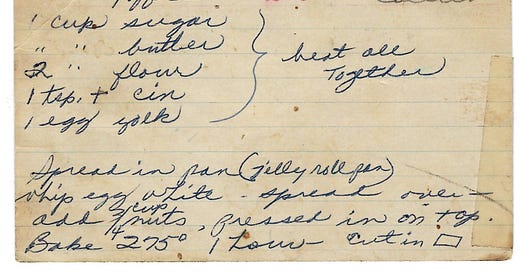



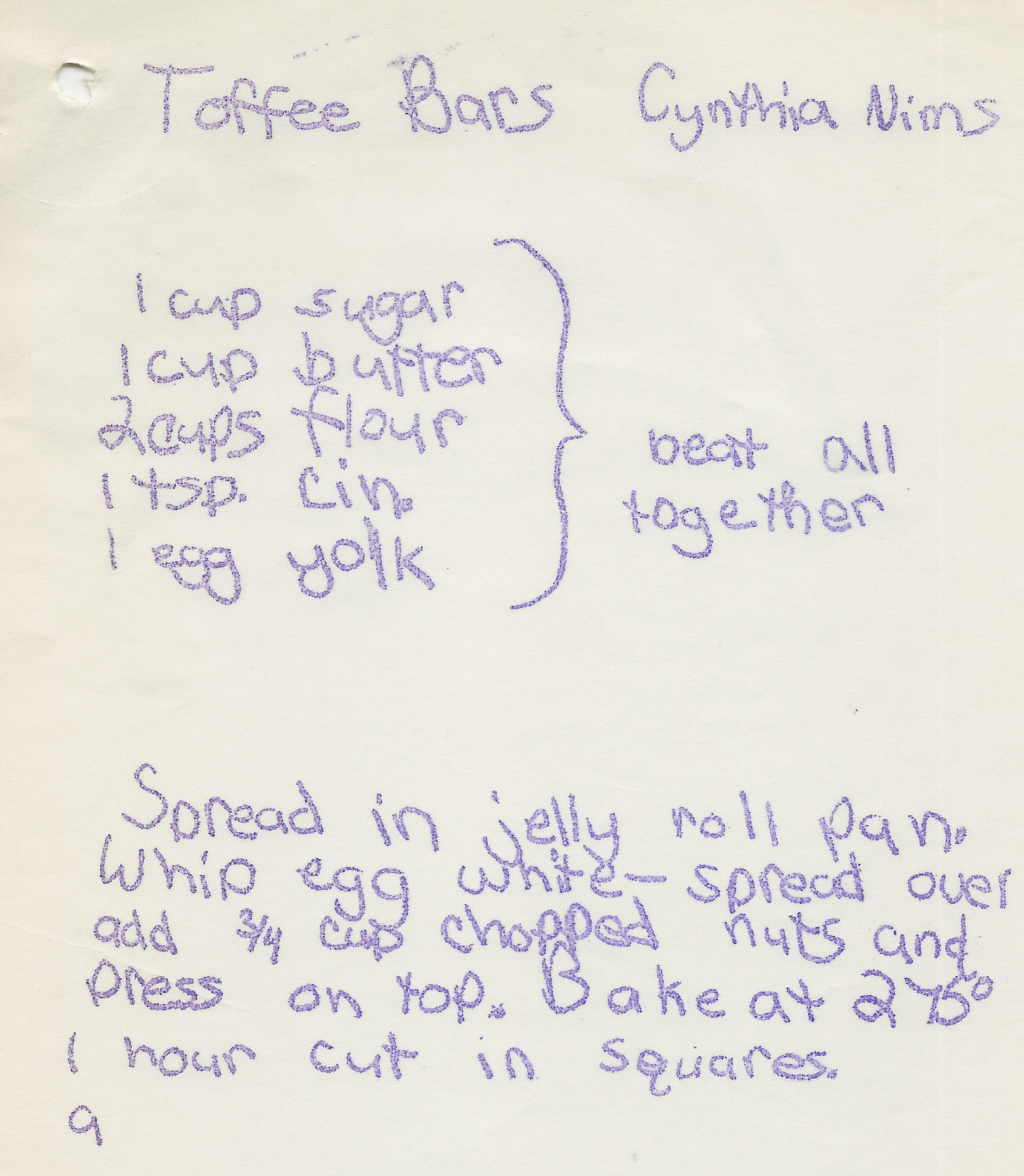
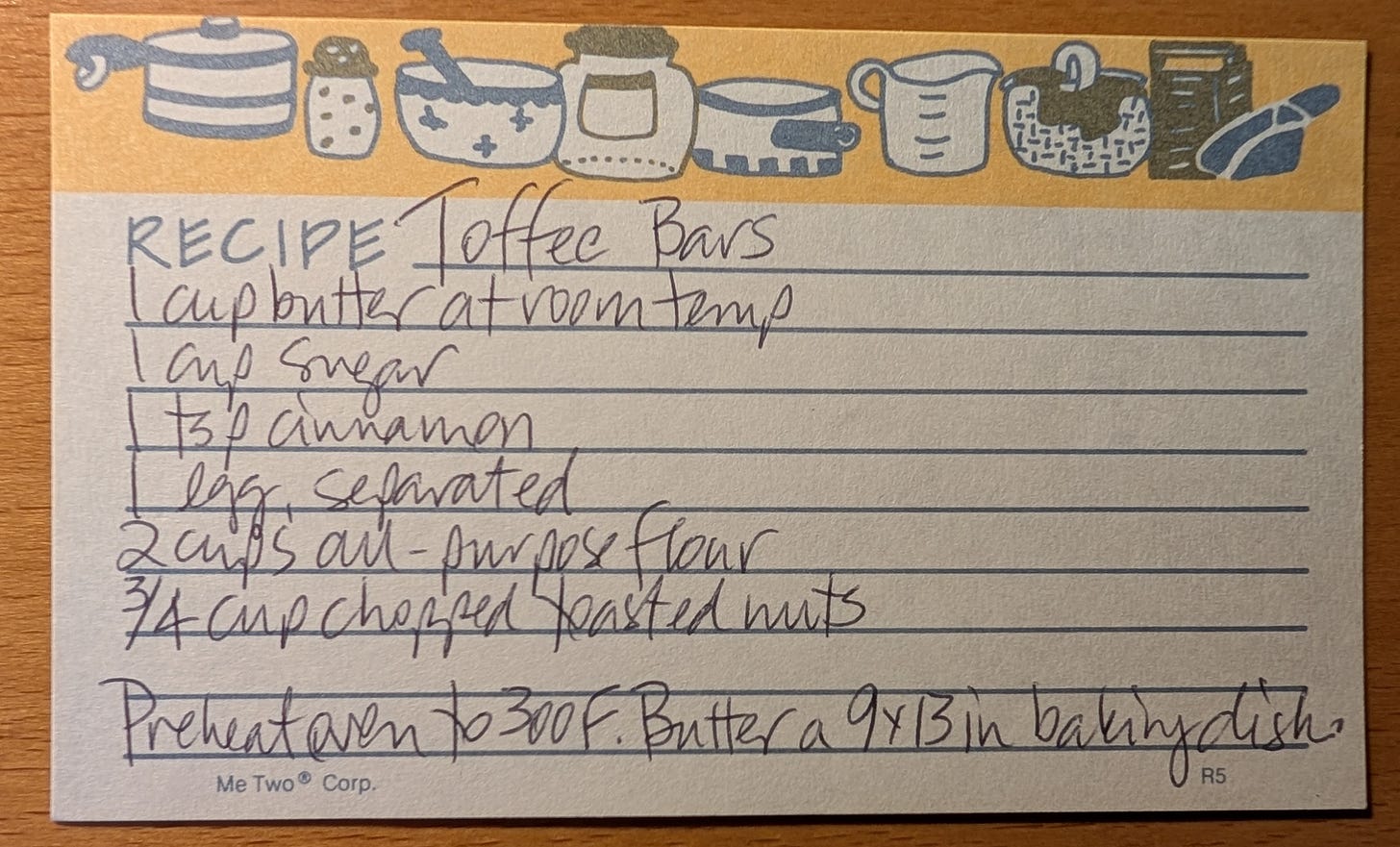
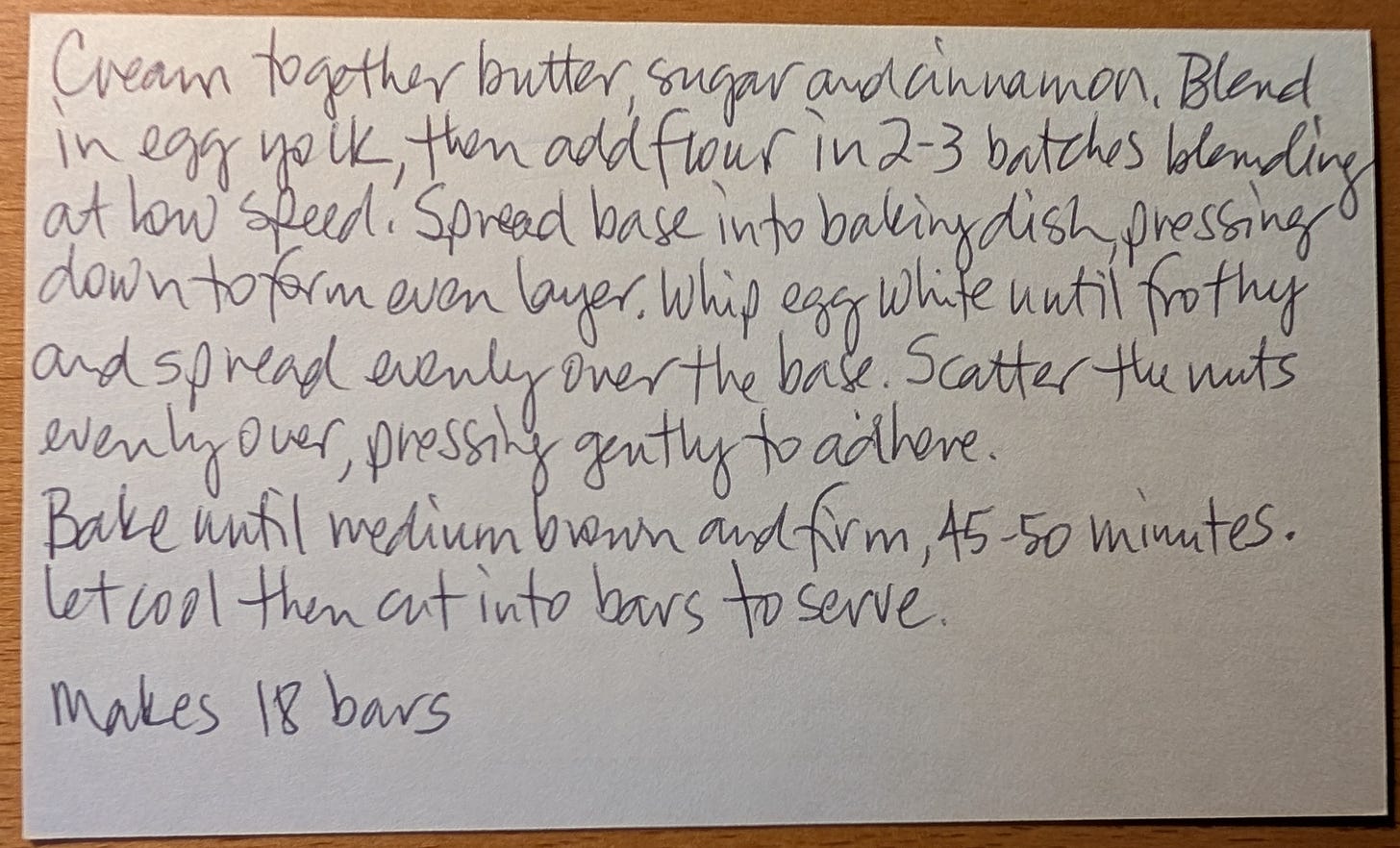
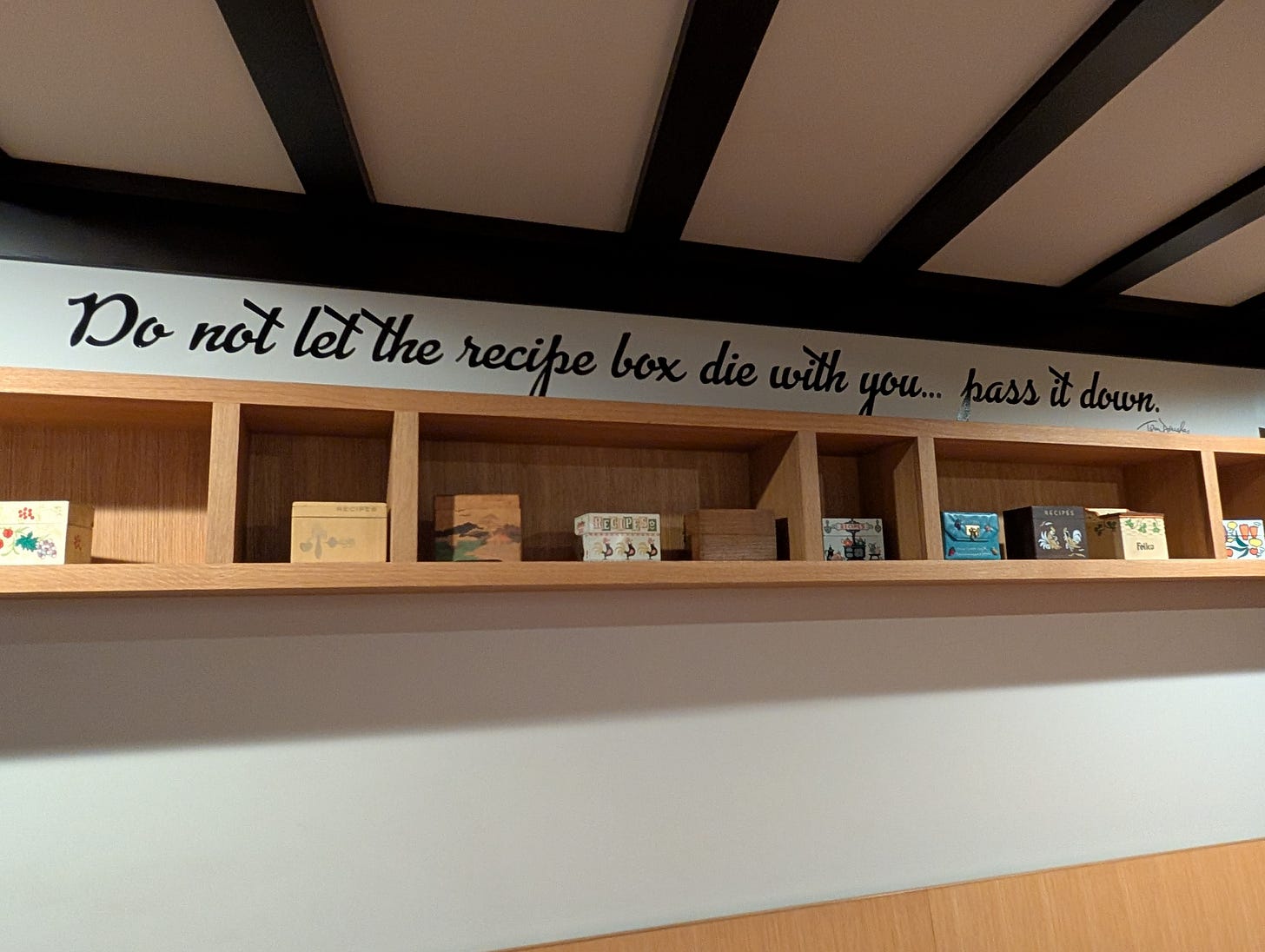
I agree- "filling the gaps" is a challenge, but I also think it's part of the charm of a passed down recipe. My grandma's recipe for pecan pie does not mention vanilla at the top as an ingredient, but in the directions, it's mentioned as an add-in with the eggs. I think that she'd made it so many times that she just skipped over it in the list! I eventually figured it out.
Recipe card shorthand is a language all in itself. Thanks for shining a light on what I consider a true culinary skill: fitting a recipe on a tiny card. I’ve been using both 3 x 5 and their next gen 4 x 6 cards lately in pen pal recipe swaps with my subscribers, but the 4 x 6’s just don’t feel as genuine as the smaller cards. Always an achievement to squeeze a recipe on those babies!